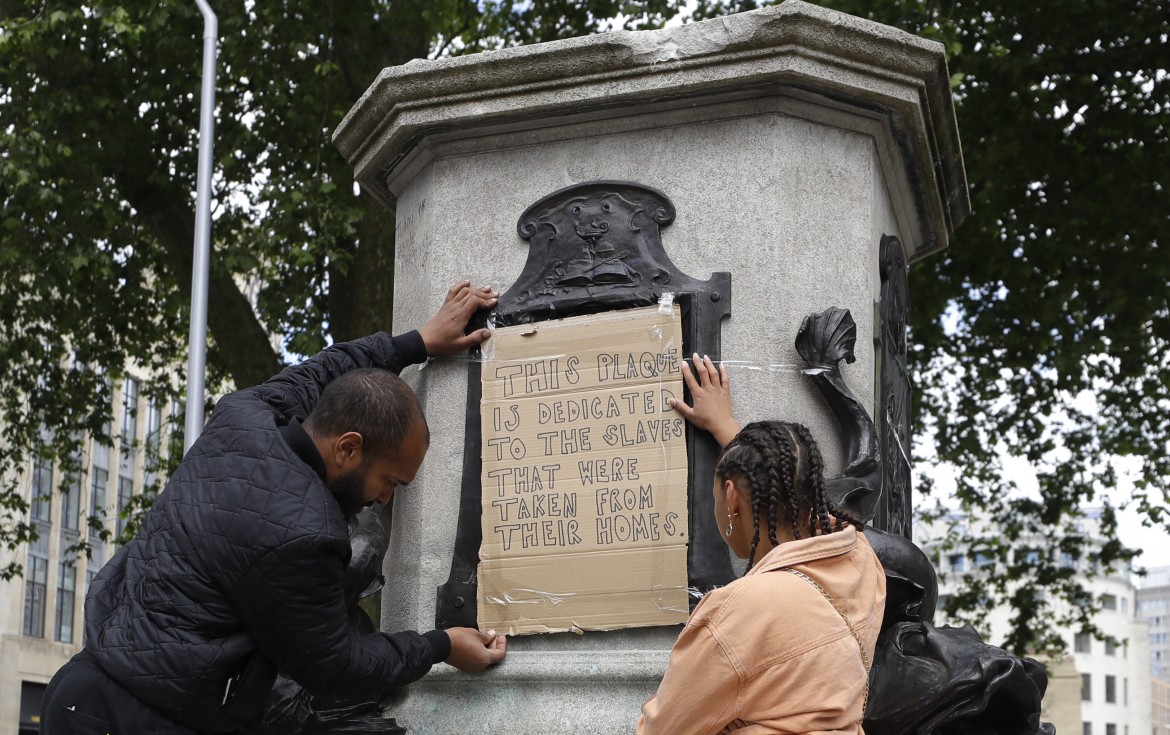Analysis
Statue controversy highlights the blood money lining Britain’s streets
The U.S. protests by the Black Lives Matter movement in the aftermath of the murder of George Floyd have crossed the same ocean over which the British colonial companies used to trade human beings as merchandise.

There is controversy over the intervention of the police in the aftermath of the demolition of the statue of the slave trader Edward Colston in Bristol by antiracist protesters, and after the clashes in London in the area of Downing Street, which resulted in a mounted policewoman falling off her horse and getting seriously injured and the Churchill monument being covered in graffiti.
In Bristol, the police officers took the reasonable course of letting the protesters do what they’d set out to do, avoiding far more serious problems. However, Boris Johnson condemned the episodes, describing the protests as “subverted by thuggery,” and Priti Patel, the hard-right-leaning Minister of the Interior, agreed, unwilling to say a word about how odious the effigy of the late 17th-century “philanthropist” was and focusing exclusively on the illegality of the action.
Those in London and Bristol were the only demonstrations in which there was civil unrest. The others, in Sheffield, Manchester and Belfast, took place peacefully. The new Labour leader, Keir Starmer, and the Mayor of London, Sadiq Khan, both criticized the violence, although the former had the courage to say that the statue should have been removed peacefully and put in a museum long ago.
As they spread throughout the Western world, the U.S. protests by the Black Lives Matter movement in the aftermath of the murder of George Floyd have crossed the same ocean over which the British colonial companies used to trade human beings as merchandise.
The images that arrived from Bristol over the weekend partly brought to mind those of the statue of Saddam Hussein in Baghdad: the monument to Colston uprooted with tie rods, rolled over and then dumped into the waters of the port—the place where the ancestors of many of the protesters arrived in captivity and were then shipped out in inhuman conditions.
The protesters didn’t miss the opportunity to take photos of themselves with a knee on the statue’s neck, like the policeman who murdered George Floyd. The mayor of Bristol, Marvin Rees, himself of Jamaican origin, said that he saw the statue as an affront and that it would not be missed.
Indeed, the statue of Colston (officially a “merchant,” not a slave trafficker, as if it were perfectly legal to do commerce with human lives), erected over a century ago, was much hated and the object of controversy, a reminder of a city whose history and wealth have much to do with slavery.
The city is full of references to this shameful past, with streets still called White Lady and Black Boy. Colston had donated some of his wealth to the city, but it was blood money coming from selling men, women and children. He was a member of the Royal African Company, established to plunder gold deposits along the Gambia River, and which transported more slaves to America than any other competing “company”: it is estimated that it shipped about 84,000 people, of whom at least 19,000 lost their lives in the atrocious conditions in which they were being transported.
The controversy over the statue had been raging for years, but it had not been possible to have it removed, nor to change the text of the plaque, which described Colston as a charitable philanthropist, ignoring the fact that he had enormous amounts of blood on his hands: for one hundred and twenty years, anyone of African origin who passed the statue had grounds to feel insulted.
Other illustrious heroes of the British Empire also show this slightly inconvenient defect: from Admiral Nelson, just as much a slave trader, to the racist Churchill: faced with Gandhi’s movement, the great imperialist statesman hated the Indians—“a beastly people with a beastly religion”—for the unforgivable sin of wanting independence.
The next in line to be knocked down from his haughty pedestal is the appalling Cecil Rhodes, once eponymous with South Africa, another character around whom there have been—and will be—serious clashes, which will hopefully be exclusively verbal in nature.
Illustrious black personalities of sport and entertainment have also expressed solidarity with the London protest, such as Formula 1 driver Lewis Hamilton, boxer Anthony Joshua and one of the stars of the new Star Wars franchise, John Boyega.
Hamilton revealed that he had himself been a victim of racist bullying as a kid. Multiple world champion Joshua attended the demonstration in London and read a statement in which he described a “virus” that “has been declared a pandemic. It is out of control. And I’m not actually talking about COVID-19. The virus I’m referring to is called racism. … You are the vaccine. I am the vaccine. We need to speak out in peaceful demonstrations … and inject the vaccine. We must not use a demonstration for selfish motives and turn it into rioting and looting.”
Originally published at https://ilmanifesto.it/bristol-non-e-piu-schiava-giu-la-statua-del-mercante-colston/ on 2020-06-09
